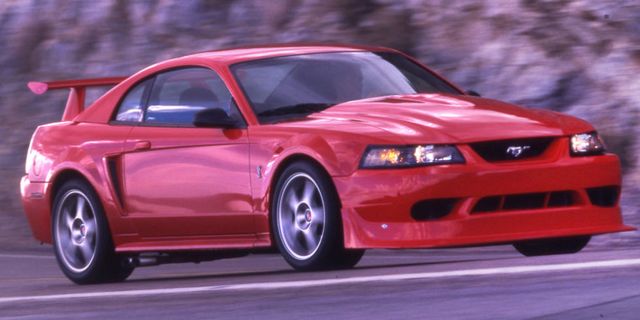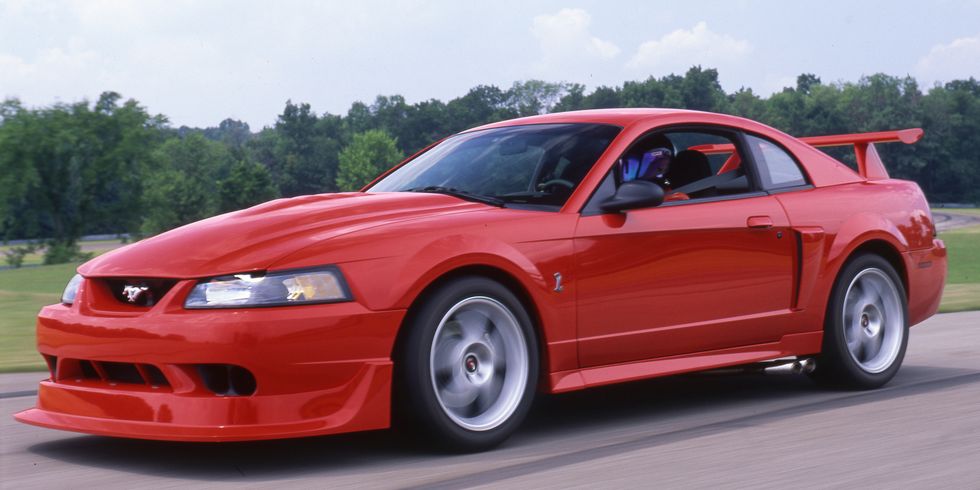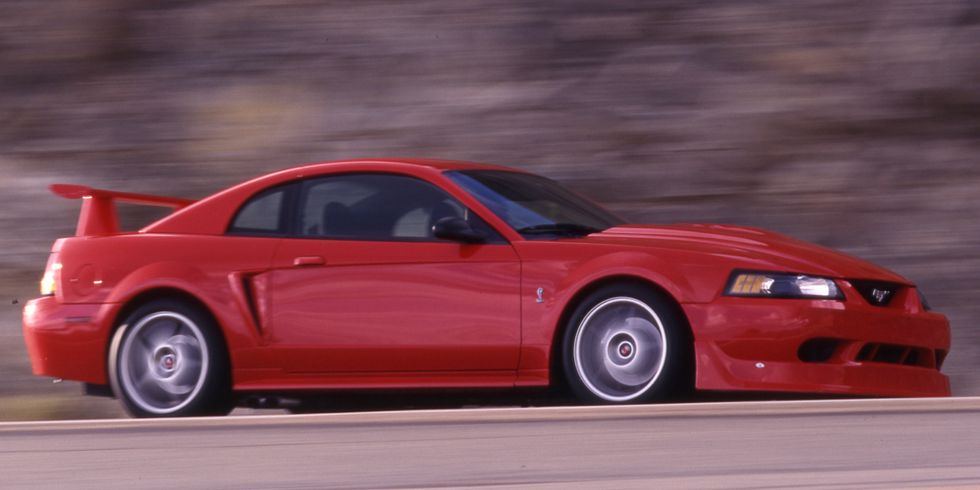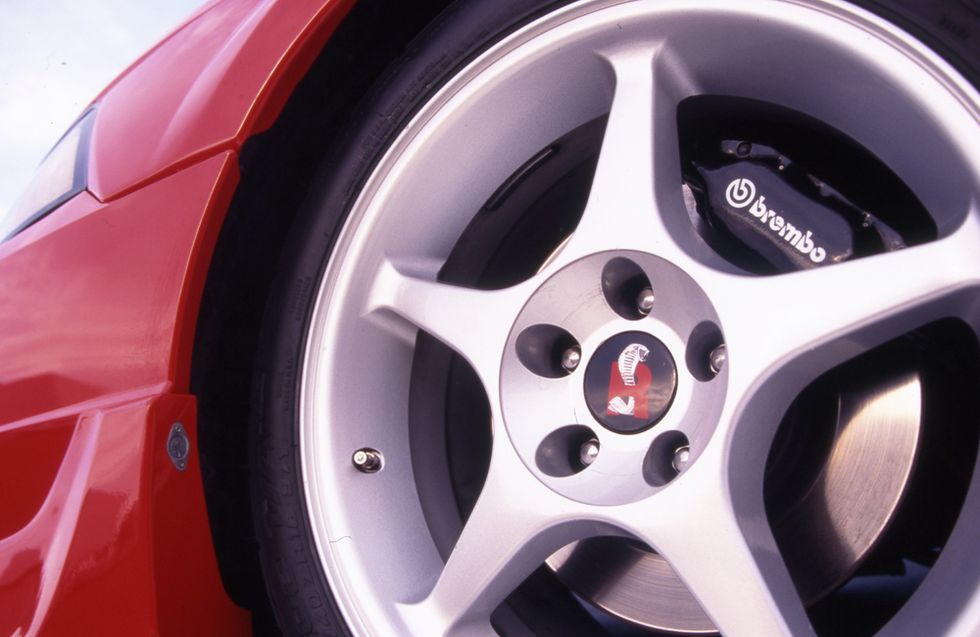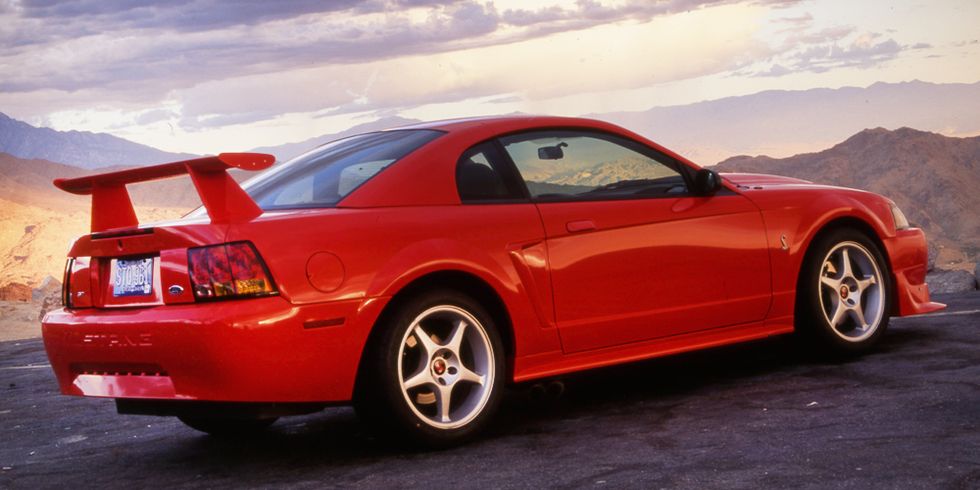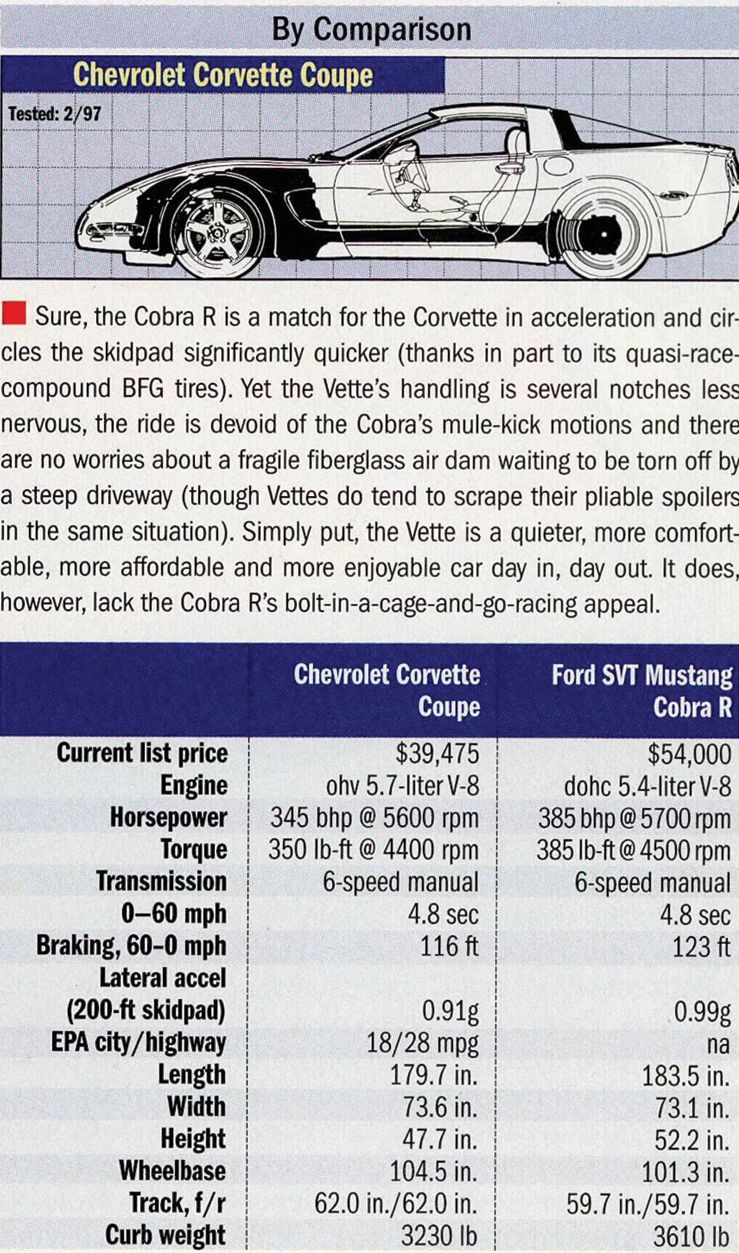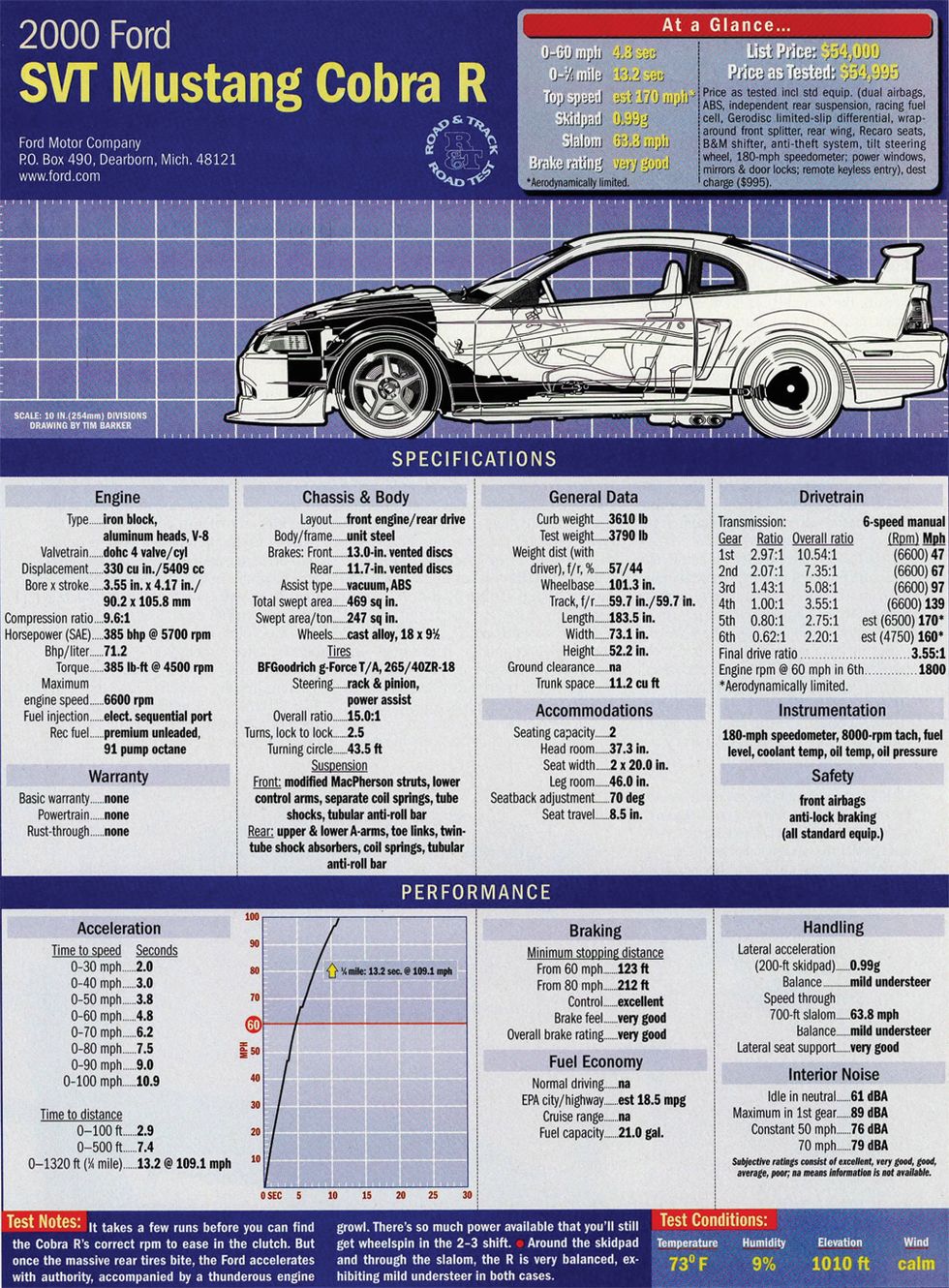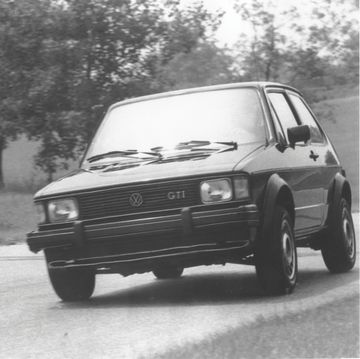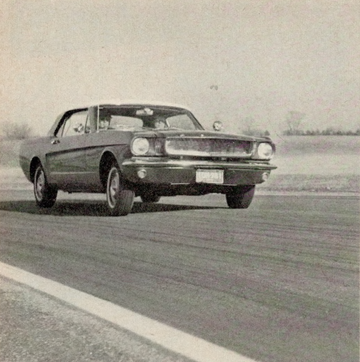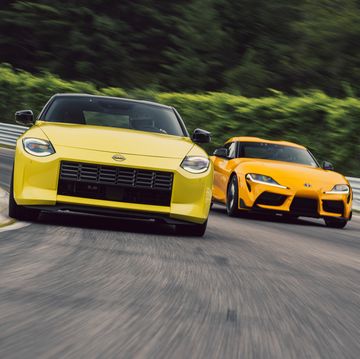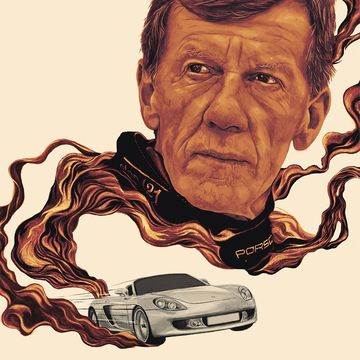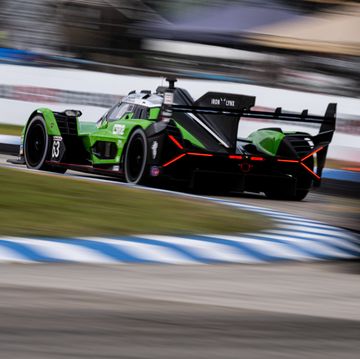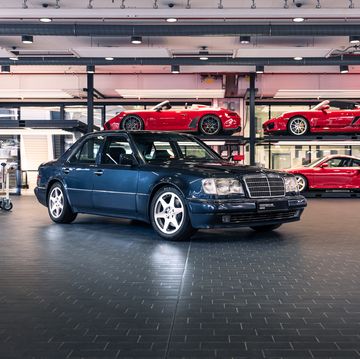From the April, 2000 issue of Road & Track.
The Great Pony Car War is over. Reaching 60 mph in a scant 4.8 seconds, the limited-production Mustang Cobra R has finally outgunned Chevy's Camaro SS. To be sure, there will be some residual skirmishing between the standard Mustang Cobra and the SS, as well as the V6-powered variants. But for the most part it's over. Don't expect an SS-R response from Chevy, because such a vehicle would clearly tread on the Corvette's turf, a scenario that has been scrupulously avoided.
That a production Mustang is being mentioned in the same breath as the Corvette brings a huge smile to Special Vehicle Engineering honcho John Coletti, the godfather of the Cobra R.
At last, Ford has the goods.
Unfortunately, Ford is planning a limited-production run of only 300, making the Cobra R a rare commodity out on the street. That doesn't lessen the impact of what Coletti & Co. have accomplished. The Mustang Cobra R delivers 385 Ib.-ft. of torque at 4500 rpm from its normally aspirated 5.4-liter DOHC Triton V8.
This cast-iron V8, a star in Ford's truck lineup, is derived from the aluminum-block modular 4.6-liter V8 used in the Mustang. While bore centers are the same, the Triton has a 29-mm-taller deck and a 105.8-mm stroke, 15.8 mm longer, giving it the larger displacement.
The deck height, however, was the biggest obstacle to its use in the Mustang. Coletti practiced by first shoehorning a flex-fuel Triton into the Mustang Super Stallion show car for the 1997 SEMA show in Las Vegas. Also beneath the skin were two other features worth noting, an independent rear suspension and a fuel cell, both of which are used on the Cobra R.
Like the Super Stallion, the Cobra R has new engine mounts and a cross member lowered 0.5 in. as well as a huge power dome on the hood to accommodate the taller engine.
The Triton V8 is fitted with Carrillo billet-steel connecting rods and forged aluminum pistons with flat tops to bump the compression ratio to 9.6:1. The engine has a new crankshaft damper, a Canton Racing Products oilpan and windage tray. The Cobra R also benefits from more aggressive cam profiles. The stock 10-mm lift has been increased to 13 mm on intake and 12 mm on exhaust.
But the key to the 5.4's brawniness is better breathing. The 4-valve cylinder heads feature larger exhaust ports, which help increase airflow by 25 percent over the Cobra's stock 4.6-liter engine. The intake manifold sports spectacular, curved air trumpets that are hidden beneath the plenum cover. Coletti wishes the cover could be made transparent to show off this bit of casting artistry.
On the exhaust side, tubular headers flow into Bassini X-pipes, which are connected to stock Cobra catalytic converters. From the catalysts back, the exhaust is routed through Borla mufflers and exits through twin chrome-tipped pipes just ahead of the rear wheels on both sides of the car. The side exhausts are necessary due to the independent rear suspension and the 21.0-gal fuel cell that block the way aft. Consequently, the Cobra R is fitted with the stock rear bumper fascia from the V6 Mustang, which has no rear cutout for exhaust tips.
Other cues that set the Cobra R apart from the Mustang Cobra include a front splitter, the high-mount fixed rear wing and rocker-panel extensions. Though the car was initially previewed in Grabber Orange, all Cobra Rs are painted a much more subdued shade of red.
The engine may be the centerpiece of the street-legal Cobra R, but just as much attention has been paid to making the car a turn-key racing machine. That's evident from the stark interior, which has no rear seat, air conditioning or sound system. The Recaro sport seats provide the kind of support you'd expect from a competition bucket with just enough padding to make it almost too comfy. The driveline is also set up to handle the rigors of racing. The short-throw Tremec 6-speed manual is mated to the same 11-in. clutch plate used in the Cobra, but to the rear is a Gerodisc hydromechanical differential that improves torque distribution especially under hard acceleration. A 3.55:1 final drive (versus the Cobra's 3.27:1 unit) and GKN halfshafts complete the package.
The Cobra R's front ride height is lowered by 1.5 in. and its rear by 1.0 in. through its Eibach springs. The rates, 800 lb. per inch in the front and 750 lb. in the rear, are considerably stiffer than the 500-lb. front and 470-lb. rear springs found in the stock Cobra and necessitate premium Bilstein shocks. Stiffer bushing material is also used on the suspension attachment points.
Out on the street, the Cobra R exhibits no rough edges. Even though much of the sound insulation has been removed to further lighten the vehicle— it still registers a hefty 3610 lb.—the Cobra R doesn't inflict the same kind of body punches you'd expect from a race car. Despite the heft of the suspension and the absolute lack of body roll, there is enough fore-and-aft compliance to make the ride bearable. The action of the rack-and-pinion is linear, with a nice solid feel. The unit is from the Cobra and benefits from a new boost curve and stiffer T-bar to enhance on-center feel.
The throaty exhaust barks with an urgency that is directly proportional to the accelerator angle. The Cobra R is brutally fast. Without much effort I found myself hitting 135 mph on a long open straight. Coletti believes the car is good for 170-175 mph and was preparing to take the car to Ford's 5-mile oval in Kingman, Arizona, to do just that.
Still, the way the car is set up for the track makes it feel skittish out in the real world, with its crowned roads and uneven pavement. As a result, the Cobra R requires undivided attention. The rear, in particular, is prone to trammel on rough roads.
This nervousness aside, the Cobra R acquits itself quite well as a street machine, but it really comes alive on the racetrack, where features like the 4-piston Brembo brakes cooled via carbon- fiber ducting can be appreciated. I had the opportunity to drive both a stock Cobra R and one fitted with a rollcage and a differential cooler that was being used in a 24-hour durability test under competition conditions at the Texas Motorsports Ranch outside Fort Worth.
Set up as a country club for car enthusiasts, the Texas Motorsports Ranch circuit is demanding, with relatively short straights that leave little time to rest, contemplate the many turns or fully enjoy the Cobra R's ability to attain high speeds. Yet, the difficult layout demonstrated the accuracy of the steering, the willingness of the suspension to respond to those inputs and the effectiveness of the braking package. In track testing we were able to haul the Cobra R down from 60 in 123 ft. and from 80 in just 212.
If the stock Cobra R was good, the track version was flat-out great. The rollcage on the endurance car stiffened the structure that much more, which again allowed the steering and chassis to work more efficiently. Equipped with competition-level brake pads, the race-prepped Cobra R didn't miss a beat. Even after it was flogged for 24 hours, it was still quick, surefooted and above all predictable. If the back end stepped out, it was easy to gather back up and with tremendous reserves of power, to get back up to speed in short order. The independent rear suspension, unlike the live axle in the Mustang GT, has a nice, settled feel to it. The strength of the Cobra R isn't so much the 385 bhp, but rather the 385 lb.-ft. of torque, which is doled out in a nice fat band between 2000 and 4000 rpm. On some of the tighter portions of the track where 2nd gear was the preferred choice, 3rd would suffice, thanks to the abundant torque.
This car is big fun, the sort that begs to be driven hard on the throttle. It pulls mightily out of the corners and over steer is easily summoned with a quick stab on the accelerator. While the Cobra R is a winner in the Mustang versus Camaro war, and runs through the quarter mile in a virtual dead heat with the current Corvette, it's a Pyrrhic victory at best because a mere 300 cars are being produced at a premium price— $54,995. Therein lies the real challenge for Ford. The Cobra R is a nice start—now let's see some real numbers, as in volume, out on the street.
